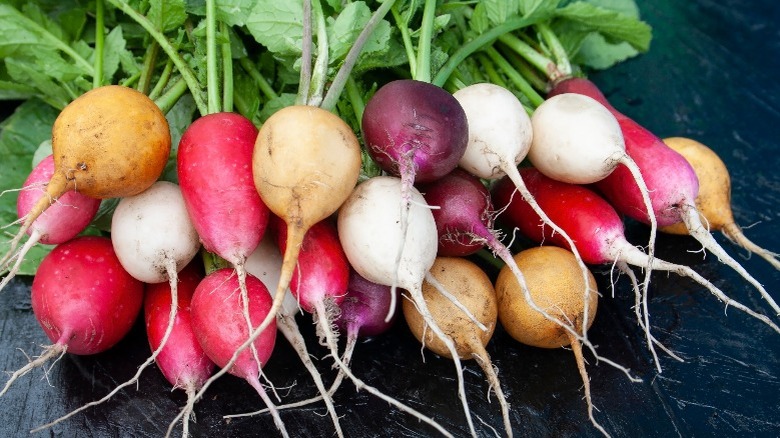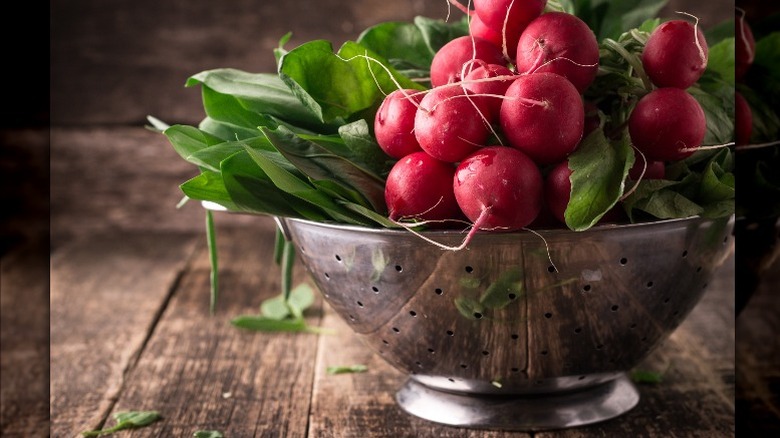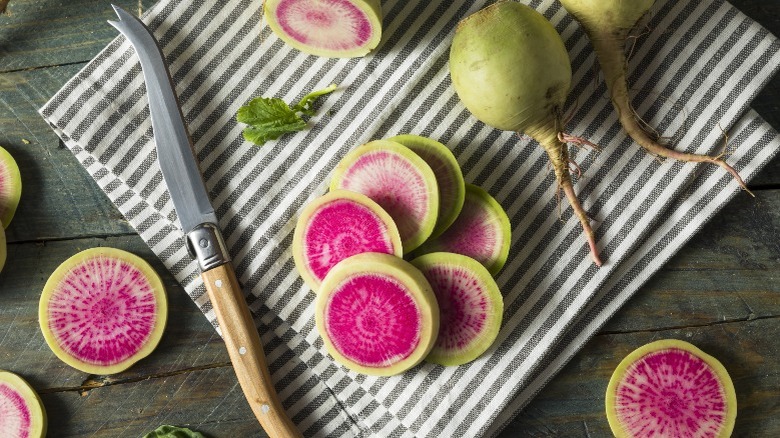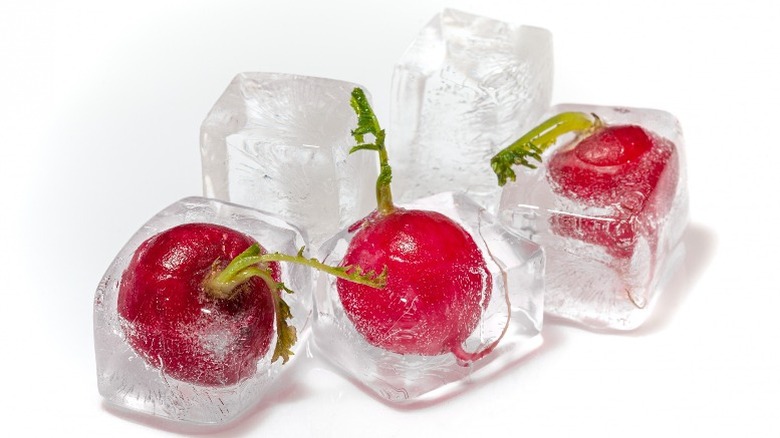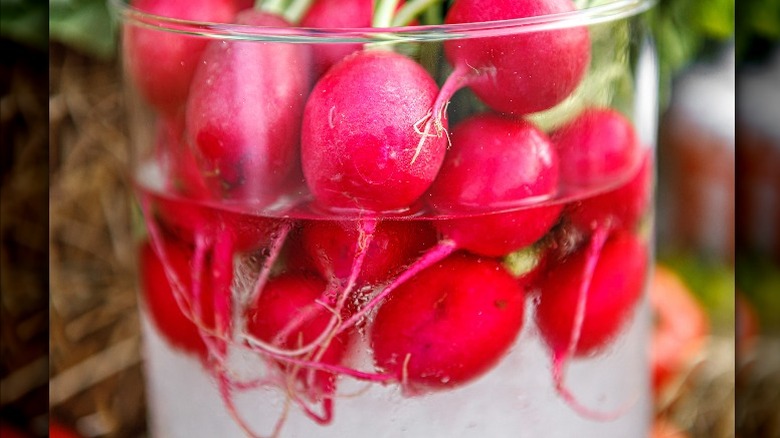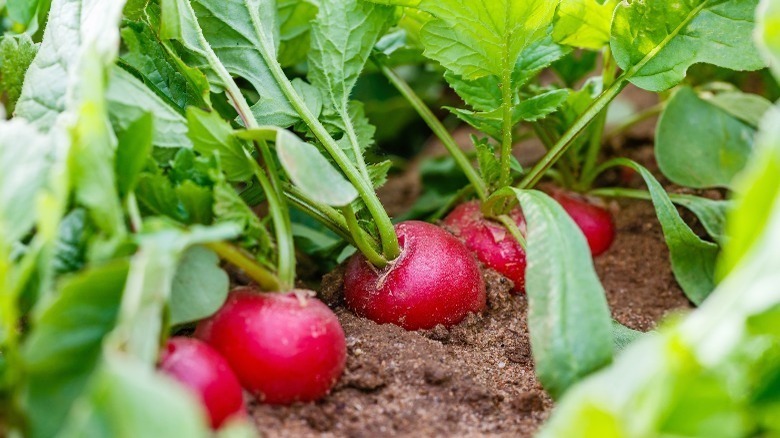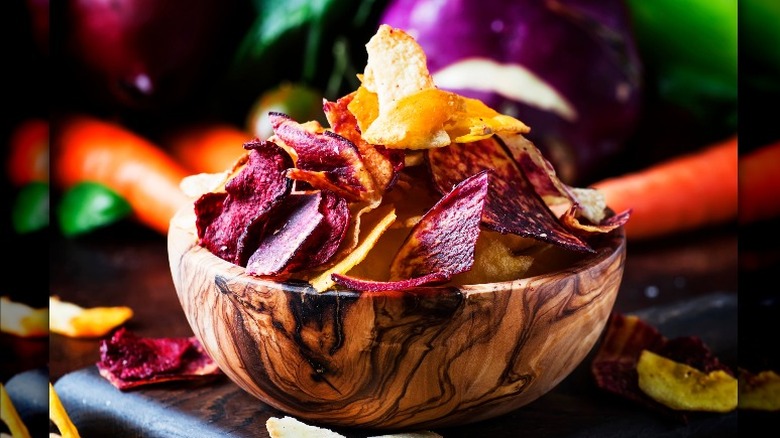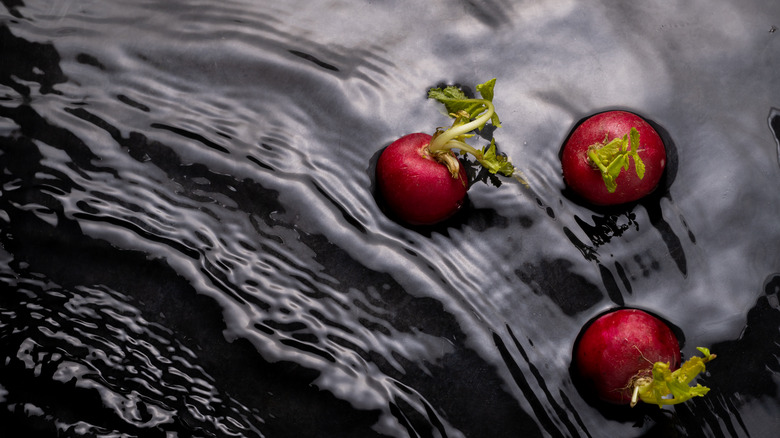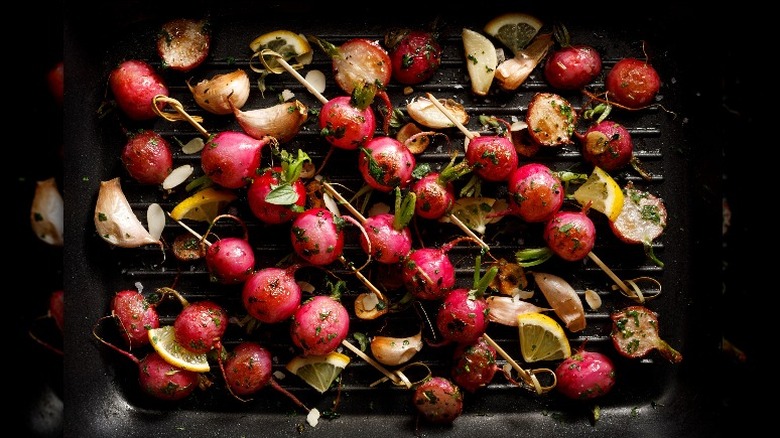10 Tips For Cooking With Radishes
One of the tiniest root vegetables, radishes have long been known primarily as that garnish no one eats. But with more people turning towards plant-based diets, these spicy little orbs are gaining a following with foodies looking for new tastes and textures to elevate their snacking. Far from just the bright red and white ones that you're used to, radishes actually come in a range of stunning colors and delicious degrees of heat, from mild breakfast ones to the nasal-clearing grandaddy of them all, horseradish.
The wide variety means that you can experiment with using them in loads of different recipes. As a root vegetable, they'll stand up to being tossed into stews and braises. But for something more on the refreshing side, radishes make an exceptionally tasty coleslaw with a simple squeeze of lime and even a superb kimchi with a bit of fermentation. We bet your interest is peaked already.
Get to know the different types of radishes
It's likely that there are far more varieties of radish than you realize. Cherry Belle or Red Globe (the round, red ones that we all know), the stunningly different watermelon (the one with the gorgeous pink insides), and daikon (the large, white, carrot-shaped ones from Japan) are fairly common types. But if you spend a lot of time at farmers' markets or just love food, you may have noticed some other stunning choices.
French breakfast radishes are becoming more common stateside because of their crunchy mildness and affinity for being paired with butter. Looking for something with a bite? The white icicle variety is pretty tiny, all-white (unsurprisingly), and rather spicy. And the Black Spanish radish, while elusive, is a striking study in black (the peel) and white (the insides). The Sakurajima mammoth is exactly what it sounds like — an enormous radish that's grown in Japan. It has a lovely mild flavor with a little sweetness, in spite of the fact that it can reach up to 100 pounds (via Gardening Know How).
Keep radishes fresher in cool storage
As a root vegetable, radishes will last longer in a cool space, just like your harvest of beets, carrots, and turnips. That gives you a few options, so don't panic. Radishes will last at least two weeks (and up to a month, if you're extra diligent) at home if taken care of properly. And the options aren't hard, we swear. Simply tossing them into your root cellar is the most basic option and works just fine.
To gain even more veggie time, clean those sweet little spheres and remove the roots and leaves. Hang on to the greens (until you finish this article), but the roots can be composted without guilt. Take the still-damp radishes and just drop 'em into a baggie with a damp paper towel (as per Busy Creating Memories) before stowing them in the fridge.
Pickling them is more labor intensive but is a great option if you have more radish than you know what to do with. One of the best ways to store radishes, pickling provides a long-term storage option and delicious flavor, all at the same time.
The best ways to slice radishes
More often than not, radishes are sliced thin when you're eating them raw. There's something about the nearly translucent, delicate slices that really stand out when strewn across the top of a salad or gorgeous open-faced radish toast, but it doesn't just come down to looks here. If you're using a particularly pungent root, thinner slices will help assuage some of the heat while keeping a bit of the crunch you crave.
You can either use a sharp chef's knife or a mandolin to get the thinnest slices; use whichever method you're more adept with. If using a chef's knife, the easiest way to start is by cutting the top and bottom of a clean radish (via Home Cook Basics). This will give you a stable base, rather than trying to shave slivers off of a veggie that rolls around your cutting board, creating chaos. If you decide to use a mandolin, for the love of all things handheld, please use the guard or a cut-resistant glove so you can go on to slice another day.
Sometimes, you want to go old school and carve them into beautiful garnishes you can eat once the party's over. Trust people who make knives to have the know-how.
Freeze radishes for even longer storage
If you need a longer-term solution that doesn't involve pickling, you can certainly freeze those gorgeous globes with little consequence — as long as you're not hoping for crunchy, raw radishes six months from now. Blanching before freezing will help preserve some delightful crispness and color by reducing "their natural enzymatic ripening reactions" (as per Fork in the Road). Ok, enough science — here's what to do.
Prepare them in the same way as you would typically — wash and trim. Fork in the Road suggests cutting them into quarters and then simply blanching for a few minutes, cooling in ice water, and drying the radishes before bagging them up and tossing them into the freezer for later use. Vacuum-sealed bags are preferable, but some of us don't have that kind of kitchen space, thank you very much. A well-sealed freezer bag will work almost as well if you don't have a vacuum seal handy.
The best ways to deal with soft radishes
Sometimes, all the tasty bits and pieces in your fridge just get away from you before you can eat, pickle, or freeze them in pristine condition. So, what else can you do?
Perhaps the easiest method to pep up your little flavor bombs is to give them a little time to chill. Lop off the tops and the root, fill a bowl with ice water and dump those slightly squishy babies right in. After an hour or so, they'll be rehydrated and as crunchy as new (via My Recipes).
Otherwise, this might be the time to forget about eating them raw and looking into the best ways to cook up those pungent beauties. Again, pickling is a great way to go with any veg past its prime. Roasting, grilling, sautéeing, or tossing them into a slow-braise dish are all terrific uses for not-so-crunchy radishes.
Don't forget to take advantage of the leaves
Let's say that you've followed our advice so far but still have one burning question: What about all these leaves? Composting is noble and makes for incredible houseplants but eating them might be even better. Please note that all of this advice pertains to leaves that are freshly lopped off your recent radish acquisitions. Leaving them on lets them absorb precious moisture from the attached ruddy red treasure (as per Love & Lemons), so instead, trim the greens and wrap them in a damp paper towel until ready to use — up to three days. You didn't buy them just to eat the leaves after the radishes shriveled up and died, did you?
Now what? Radish greens can be used like most leafy greens — toss them into a salad for a peppery bite, sautée with garlic if you want to subdue that flavor or make a truly delish radish pesto that has an unexpected zip.
How to substitute radishes for other root vegetables
Say that you've got a penchant for everything tasty, but you've also made enemies with carbs. Given the number of radishes out there, you might just be able to substitute a handful of spicy beauties for those boring old taters. Even if you haven't gone carb-free, keep listening. These ideas are still seriously scrumptious, y'all.
Give this link a try if keto-friendly roasted potato substitutes are your thing. After spending some time in the oven, those radishes lose their spicy sting and turn absolutely creamy inside and crispy outside with a significantly lower carb load. Given the difference in size, however, just be prepared to spend a bit more time prepping them.
Their root veggie status means that radishes will make a pretty terrific stand-in for nearly anything else in that family when chopped up; they'll retain their shape and creamy interior in the majority of cooking options.
The best ways to cut the heat of fresh radishes
Suppose you want the crispy, crunchy goodness of a raw radish, but you just can't bear how spicy or bitter they can be. Luckily, we've got some answers for your brassicaceae (yeah, we're pretty smart) woes. Radishes, especially the pretty ones, make such a lovely complement to any fresh salad, slaw, or crudité platter, whether served whole or sliced into fancy garnishes. But what if you're too sensitive for the heat they bring to the table?
Fear not, gentle one. There are ways to make that daikon less bitter or to take the heat out of that white icicle. Gardening Know How makes it sound pretty simple — prep them like you normally would but give them a few extra slices before popping them into some icy cool water. 45 minutes later, the horseradish-reminiscent kick is almost gone, and those little mouthfuls are ready to go.
How to grill radishes
If you're still looking for other ways to cook up radishes so you can take advantage of a softer and more delicate flavor, we have yet another option for you. We're huge champions of everything vegetarian for your grill, including any radish you can get your mitts on.
Daikon radish grilled skewers are often served in Japan, and we think that all radishes shine when given the same treatment. But since we believe that most veggies are better grilled, why trust us that radishes are the answer here? Not only does grilling tame their bite, but it also gives them that sweet, crispy skin that everyone loves. And it's faster than roasting, so that you can tame those hunger pangs sooner. Slice off the root and stems, thread onto skewers and drizzle with oil. Add your choice of seasoning and light the barbecue. Done and done.
Don't overlook radishes at cocktail hour
If cocktail hour is something that inspires you to cut loose and try something new, then this is the paragraph that you've been waiting for. First of all, as we mentioned before, radishes with butter and salt are a match made in heaven. Eaten in France as a breakfast item, it also makes an incredibly tasty cocktail side dish. Don't believe us? Certainly, Dorie Greenspan's rave review of buttered and salted radishes will do.
And finally, if that's not enough, let us propose one last way to wow your tastebuds with these little flavor bombs. The Red King, a radish and gin cocktail, should convince you that sometimes veggies are indeed better when disguised. Not only used as a gorgeous garnish, macerated radishes also give the sublime cocktail an unexpected kick and a hint of pink. We think that combination sounds totally rad.

